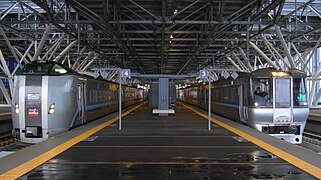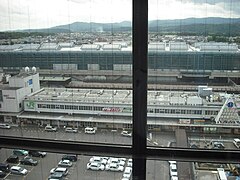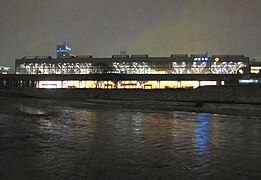Asahikawa Railway Station
| Asahikawa ( 旭川 ) | |
|---|---|
 View of the train station (May 2012)
|
|
| Data | |
| Location in the network | Separation station |
| Platform tracks | 7th |
| abbreviation | A28 |
| opening | July 16, 1898 |
| location | |
| City / municipality | Asahikawa |
| prefecture | Hokkaidō |
| Country | Japan |
| Coordinates | 43 ° 45 '46 " N , 142 ° 21' 31" E |
| Height ( SO ) | 109 m TP |
| Railway lines | |
|
Decommissioned: |
|
| List of train stations in Japan | |
The Asahikawa Station ( Jap. 旭川駅 , Asahikawa-eki ) is a train station on the Japanese island of Hokkaido . It is located in Kamikawa Sub-Prefecture in the Asahikawa City area and is an important transportation hub.
links
Asahikawa is the end and starting point of four lines, all of which are operated by the JR Hokkaido railway company . The station is thus one of the most important hubs for rail traffic on Hokkaidō. The main railway line on the island, the Hakodate Main Line to Sapporo and Hakodate, runs to the west . The Sōya main line to Wakkanai runs northwards, while the Furano line runs south to Furano . Likewise, all trains run from Asahikawa on the Sekihoku main line , which branches off the Sōya main line in Shin-Asahikawa station 3.7 km away and leads to Abashiri .
On the Hakodate main line, the Super Kamui express train, which runs every 30 or 60 minutes, provides the fastest connection with Sapporo, with a journey time of one hour and 25 minutes for the 136.8 km route. On the Sōya main line there are two pairs of express trains Super Sōya and one pair of Sarobetsu trains every day , both on the Sapporo – Asahikawa – Wakkanai connection. On the main Sekihoku line, the Okhotsk express train runs four times a day from Sapporo via Asahikawa to Abashiri. In addition, there are regional trains running at irregular intervals on the three lines mentioned . The Furano line is reserved for local traffic, supplemented by a nostalgic train on weekends.
There is a bus terminal on the station forecourt , which is served by city and regional lines of several companies.
investment
The station is located on the southern edge of the city center near the bank of the Chūbetsu-gawa River. It is a through station on a wide viaduct , which is enclosed by a three-storey station hall . The entrance is at ground level, the second floor serves as a distribution level . The seven covered tracks are located on the top floor on three central platforms and on a side platform .
The current complex was built according to plans by the architect Hiroshi Naito. The executing companies were Shimizu and Kumagai Gumi. The 180 meter long and 22 meter high station concourse consists of mighty support struts and curtain walls . The walls and ceilings on the two lower levels are clad with wooden panels. The design was recognized by the Japanese Association of Railway Architects and the Japanese Institute of Lighting Technology.
On the ground floor there are various service facilities, shops, restaurants and the city tourist information center, as well as an art gallery (branch of the Asahikawa Sculpture Museum). Immediately to the northwest of the train station (with a direct connection) is the Aeon Mall ( イ オ ン モ ー ル ) , which opened in 2015 . The Heiwadōri ( 平和 通 ) shopping street , Japan's first permanent pedestrian zone, begins opposite the main entrance .
Tracks
| 1 • 2 | ▉ Furano line | Furano |
| 3 • 4 | ▉ Hakodate main line | Fukagawa • Takikawa • Iwamizawa • Sapporo |
| 5 • 6 | ▉ Sōya main line | Nayoro • Wakkanai |
| ▉ Sekihoku main line | Engaru • Kitami • Abashiri | |
| 7th | ▉ flexible | arriving and departing trains and freight trains |
history
The state railway company Hokkaidō Kansetsu Tetsudō opened on July 16, 1898 the northernmost section of the Hakodate main line between the Sorachi Bridge at Sunagawa and Asahikawa. On August 12, 1898, she took the subsequent first section of the Sōya main line to Nagayama into operation. Three weeks later, on September 1, 1898, the first section of the Furano line to Biei was opened. As a result, Asahikawa station was a traffic hub in its first year of operation. In 1904 a new station building was built, which was replaced by a new building in 1960. From 1930 to 1956 a tram line ran to the station.
After the opening of a new double-lane route from Takikawa through the Ishikari Valley to Asahikawa on October 1, 1969, the station was served by electrically powered trains for the first time. Also electrified since May 10, 2003, the subsequent section of the Soya Main Line to the freight station Kita-Asahikawa on the northern outskirts. In November 1973, the Ministry of Transportation designated Asahikawa as the northern terminus of the Hokkaidō Shinkansen . However, it is unlikely that this high-speed line will ever reach the city.
For reasons of profitability, the state railway stopped checking in luggage on November 1, 1986. As part of the privatization process, the station became the property of JR Hokkaido on April 1, 1987 . The department store in the basement of the station was closed in 2004 after 44 years of operation. In 2010, the station was torn down and a new building was built about 70 meters south of it; about 3.5 km of railway line was laid on a viaduct. The new station was fully commissioned on November 23, 2011.
photos
Adjacent train stations
|
←
|
Lines |
→
|
||
|---|---|---|---|---|
| Chikabumi |
JR Hokkaido |
The End | ||
| Beginning |
JR Hokkaido |
Kaguraoka | ||
| Beginning |
JR Hokkaido |
Asahikawa-yojō | ||
| Beginning |
JR Hokkaido |
Asahikawa-yojō | ||
Web links
- JR Hokkaido Station Information (Japanese)
Individual evidence
- ↑ 旭川 駅. Hiroshi Naito, accessed July 5, 2016 (Japanese).
- ↑ 平 成 23 年 照明 普及 賞. Illuminating Engineering Institute of Japan, accessed July 5, 2016 (Japanese).
- ↑ 入選 : 旭川 駅 舎. Association of Railway Architects, accessed July 5, 2016 (Japanese).
- ↑ JR Asahikawa Station. japantravel.com, December 4, 2013, accessed July 5, 2016 .
- ↑ Kazuo Tanaka: 写真 で 見 る 北海道 の 鉄 道 (Hokkaidō's railroad in photos) . tape 1 . Hokkaidō Shinbunsha, Sapporo 2002, ISBN 978-4-89453-220-5 , pp. 38-39 .
- ↑ Tanaka: 写真 で 見 る 北海道 の 鉄 道, pp. 314–315.
- ↑ Tanaka: 写真 で 見 る 北海道 の 鉄 道, p. 36.
- ↑ Shuichi Takashima: Current status of Hokkaido Shinkansen. (PDF, 1.0 MB) (No longer available online.) In: Japan Railway & Transport Review 57th East Japan Railway Culture Foundation, March 2011, archived from the original on March 9, 2015 ; accessed on July 5, 2016 . Info: The archive link was inserted automatically and has not yet been checked. Please check the original and archive link according to the instructions and then remove this notice.
- ↑ Hokkaidō Shimbun: シ ャ ッ タ ー と 共 に 44 年 の 歴 史 に 幕 旭川 ス テ ー ー シ ン ン デ パ ー ト が 閉 店. May 1, 2004.
- ↑ 旭川 駅 グ ラ ン ド オ ー プ ン 特設 ペ ー ジ. (No longer available online.) JR Hokkaido, 2011, archived from the original on May 20, 2013 ; Retrieved July 5, 2016 (Japanese). Info: The archive link was inserted automatically and has not yet been checked. Please check the original and archive link according to the instructions and then remove this notice.







